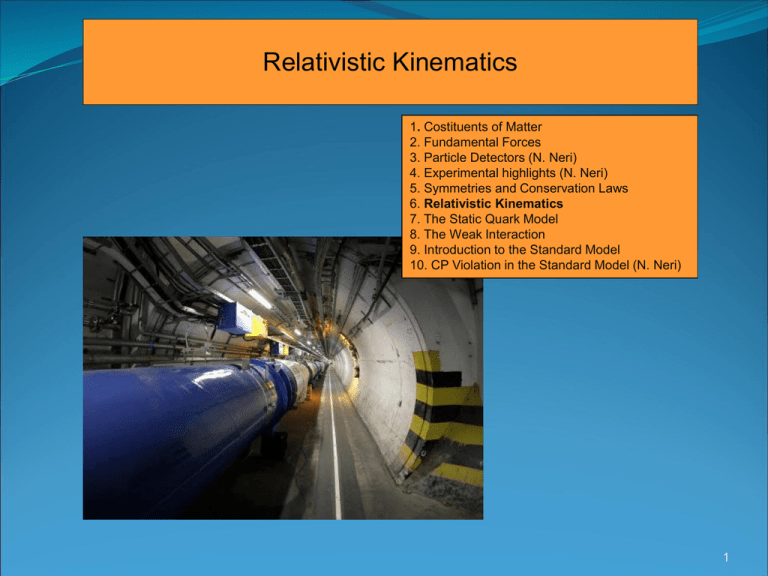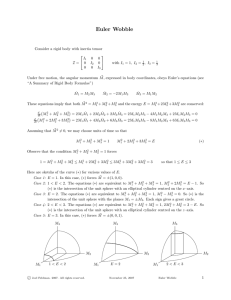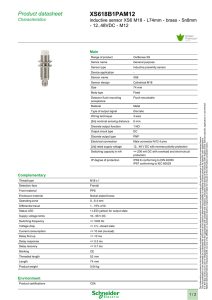Recalling Relativistic Kinematics Basic Principles
advertisement

Relativistic Kinematics 1. Costituents of Matter 2. Fundamental Forces 3. Particle Detectors (N. Neri) 4. Experimental highlights (N. Neri) 5. Symmetries and Conservation Laws 6. Relativistic Kinematics 7. The Static Quark Model 8. The Weak Interaction 9. Introduction to the Standard Model 10. CP Violation in the Standard Model (N. Neri) 1 Recalling Relativistic Kinematics Basic Principles Every experiment will give the same results whenever executed in reference frames that are in uniform rectilinear motion with respect to one another. Physical laws are the same in every inertial frame. Energy, total momentum and total angular momentum of a physical system are constant in time. The speed of light in vacuum is the same in every inertial frame : c=2.9979108 m/s (Time is not a relativistic invariant) (Space is not a relativistic invariant) 2 Four-vector : A (a0 , a1 , a2 , a3 ) (a0 , a) For example, for a particle Minkoski pseudo-euclidean metric Scalar product: p ( E , p) AB (a0b0 a1b1 a2b2 a3b3 ) (a0b0 a b ) Lorentz transformations Given 2 inertial frames Oxyz, Ox’y’z’ in relative motion and assuming that the origin of the axis coincide at a common t=t’=0 and also assuming that the uniform translatory motion be along the x axis: β=vx/c with vx velocity di O’ rispetto a O e con γ=1/(1-b2)1/2 By applying a Lorentz transformation L(b) to a four-vector A in the system O, one gets A’ in the O’ system: a' 0 0 a a a 0' a1 a' 0 2 a' 0 3 0 0 1 0 0 0 0 a1 a 0 a1 a2 1 0 a2 a3 0 1 a3 3 The Lorentzian four-vector : x y x0 y0 x y x x The Special-Relativity spacetime : x2 x x x0 x0 x x x2 0 tim e like x2 0 light like x2 0 space like The Lorentz Boost : p vp p L0 ' p 0 vpL p L' pT' pT 0 L 4 (k1 ) e ( p1 ) (k2 ) l ( p2 ) A prototype reaction In the LAB In the CM k i i , k i pi Ei , pi * * k i i , k i * * p i E i , pi Dispersion Relations 2 2 k k1 1 p12 E12 p12 m2 2 1 * * * * k1 p1 k2 p2 2 1 * k2 * k1 2 2 k k2 2 p22 E22 p22 2 2 2 * 2 2 p1* p2* Center of Mass Energy * * 2 s (k1 p1 ) ( E ) (k1 p1 ) (1* E1* )2 2 * 1 * 2 1 s 1* E1* Maximal energy that can be transformed in mass 5 In a fixed-target configuration : (k 2 ) (k1 ) e ( p1 ) (k2 ) l ( p2 ) (k1 ) m 2 2 2 2 2 s k1 p1 k1 p1 2k1 p1 m 21E1 2k1 p1 2 2 m 21m ( p1 0, E1 m) s At high energies (masses neglected) : Let’s assume k2 2 2 2 2 k1 : 1 k1 1 , k1 k 2 : 2 k 2 2 , k 2 k2 k1 s k1 k2 1 2 2 21m k1 In a collider situation : l ( p2 ) 2 k1 k2 At high energies (masses neglected) : 2 1 2 2 s ( 1 2) 2 k1 6 Threshold of a Reaction s mi Sum of masses in the final state i Example 1: production of a muon with a neutrino beam impinging on e s k1 p1 2 m 2 2 1m (k 2 ) 2 m 2 2 1m 2 Muon mass (k1 ) 1 m 2 m2 2m l ( p2 ) Example 2: muon production in e+e- collisoins (collider) s ( 1 2) 2 k 2 k 106 MeV Two muons to conserve leptonic numbers 11,130 0.3 11 GeV 1.02 k,m k,m 7 Unstable particle: two-body decay E1 E2 m12 p12 p1 p2 0 P p1 p2 p p m22 p22 M p1 ( E1 , p1 ) M p2 ( E2 , p2 ) in this section only m12 p 2 m22 p 2 M M m12 p 2 m22 p 2 M 2 m1 m2 (m1 m2 ) 2M m12 p 2 M 2 m12 2M m12 p 2 m22 M 4 m1 m2 (m1 m2 )2 2M 2 m1 m2 m1 m2 4M 2 (m12 p2 ) 2 M 4 m1 m2 (m1 m2 ) 2 2M 2 m12 2M 2 m22 p 4M 2 2 M 4 m1 m2 (m1 m2 ) 2 M 2 (m1 m2 ) 2 M 2 (m1 m2 ) 2 2 p 4M 2 2 2 p1 p2 M 2 (m1 m2 ) 2 M 2 (m1 m2 ) 2 2M • Possible only if M m1 m2 • Momentum uniquely defined 8 …and the energies of the two particles E12 m12 p12 p22 E22 m22 E2 E12 m12 m22 E1 E2 M M E1 E2 M E1 E12 m12 m22 2ME1 M 2 m12 m22 E1 1 M 2 m12 m22 2M and, similarly : E2 1 M 2 m22 m12 2M Because of momenum conservation, 1 and 2 are heading in opposite directions in the M reference frame If 1 and 2 happen to have the same mass : 1 E1 E2 M 2 1 p1 p2 M 2 4m 2 2 9 P 4 vector Two body decays in flight p 3 vector in this slide P1 ( E1 , p1T , p1z ) P ( E,0,0, p) pT 2-vectors P2 ( E2 , p2T , p2 z ) pT p1T p2T Momentum conservation in the transverse direction : Between the CM and the laboratory : p vE p vE E1 E1* vp1*z E2 E2* vp2* z * p1z 1z p1T p1*T * p2 z 2z p2T p2*T Kinetic energy and mass energy : E 2 p 2 m2 p2 m2 1 2 E2 E 2 p m2 1 1 1 1 (1 v 2 ) v 2 2 2 2 2 E m * 1 * 2 E m c 2 m c 2 m c2 m c2 m ( 1) c 2 m c2 T m c2 E m c 2 v p E E M 10 Mandelstam variables Let’s introduce three Lorentz scalars : p1 p3 p2 p4 s p1 p2 p3 p4 2 2 t p1 p3 p4 p2 2 2 u p1 p4 p3 p2 2 2 And : s t u ( p1 p2 )2 ( p1 p3 )2 ( p3 p2 )2 p12 p22 p12 p32 p32 p22 2 p1 p2 2 p1 p3 2 p2 p3 p1 p2 p3 p4 p12 p22 2 p1 p2 p32 p42 2 p3 p4 s t u 2 p1 p2 p32 p42 2 p3 p4 p12 p32 p32 p22 2 p1 p2 2 p1 p3 2 p2 p3 p12 p22 p32 p44 2 p3 p3 2 p3 p4 2 p1 p3 2 p2 p3 m12 m22 m32 m42 2 p3 ( p3 p4 p1 p2 ) m12 m22 m32 m42 11 Physical meaning of s: energy available in the center-of-mass s p1 p2 E1 E2 2 2 s p1 0 M 2 2 In the case of an unstable particle decaying : ' 3, k Physical meaning of t: let us see it in the CM ' t0 m m 2 k k 2 E1E3 2 1 2 3 2, k * 1, k ' 2 2 2 t ( p1 p3 ) ( E1 E3 ) k k 2 '2 ' 2 2 E1 E3 2 E1 E3 k k 2k k ' 2 2 m1 m3 2 k k cos * 2 E1 E3 ' 4, k Θ*< 900 * ' ' * 2 t t0 2 k k cos 1 t0 4 k k sin 2 * * ' ' 2 2 t t0 4 k k sin (t ) min 4 k k sin 2 2 Momentum transfer 12 Three body decay: the Dalitz plot sP M 2 P p1 p2 p3 p1 ( E1 , p1 ) 2 s1 ( P p1 ) ( p2 p3 ) 2 Invariant mass of subsystems 2 s2 ( P p2 ) 2 ( p1 p3 ) 2 s3 ( P p3 ) ( p1 p2 ) 2 2 M p2 ( E2 , p2 ) p3 ( E3 , p3 ) The subsystem invariant masses : s1 s2 s3 M 2 m12 m22 m32 Let us study the limits of the kinematics variable’s space (phase space) In the CM system: 2 2 2 2 s1 ( P p1 ) ( M E1 ) (0 p1 ) M E1 2ME1 p1 M 2 m12 2ME1 2 2 2 M m1 2M p1 m12 M 2 m12 2Mm1 2 2 max s1 (M m1 )2 13 To find the lower limit we use the CM system of 2 ,3: s1 ( P p1 ) 2 ( p2 p3 ) 2 ( E2 E3 ) 2 ( p2 p3 ) 2 2 2 2 2 2 2 2 ( E2 E3 ) p2 m2 p3 m3 m2 m3 So that, for every s: (m2 m3 ) 2 s1 ( M m1 ) 2 (m1 m3 ) 2 s2 ( M m2 ) 2 (m1 m2 ) s3 ( M m3) 2 A parallelogram ! 2 One can actually devise a better limit by considering the correlation between the variables. To this goal, let’s use the Jackson frame, defined by p3 p2 , ( P p1 ) s1 E2 E3 (E E1 )2 2 In this frame : s1 ( E E1 ) 2 2 M P m12 p12 2 2 M p12 m12 p12 2 2 14 s1 M p12 m12 p12 2 2 Inverting, to find the momentum 2 2 2 2 1 2 2 ( x , y , z ) x y z 2xy 2 yz 2xz p1 ( s1 , M , m1 ) 4s1 In addition : s p2 p3 E2 E3 2 2 2 2 p2 p3 E2 E3 2 2 2 m p2 m3 p3 2 2 2 2 2 1 p2 p3 ( s1 , m22 , m32 ) 4s1 At this point, let us consider the invariant s2 p1 p3 2 15 2 s2 p1 p3 p12 p32 2 E1E3 p1 p3 cos m12 m32 2E1E3 p1 p3 cos (1,3) Let us now suppose to fix The momenta of 1,2,3 are fixed in magnitude : s1 2 2 1 2 1 2 2 p p1 ( s1 , M , m1 ) 2 p3 ( s1 , m22 , m32 ) 4s1 4s1 s2 depends only on s2 m12 m32 2 m12 p12 m32 p32 p1 p3 cos min s m m 2 m p max s2 m12 m32 2 m12 p12 2 2 1 2 3 2 1 2 1 (1,3) p s m32 p32 p1 p3 s2 m32 p32 p1 3 2 It is possible to express the energies of 1 and 3 as a function of s, s1 16 E1 1 s s1 m12 2 s1 E3 1 s1 m32 m22 2 s1 In this way, one obtains the limits of the Dalitz Plot: s2 m12 m32 1 s s1 m12 s1 m22 m32 1/ 2 ( s1 , s, m12 )1/ 2 ( s1 , m22 , m32 ) 2s1 The Dalitz plot represents the transition between an initial state and a three-body final state. It is built up by using two independent variables. The Dalitz Plot contours are given by kinematics The density of dots in the Dalitz Plot is giving information on the dynamics of the final state particles : M ( s1 , s2 ) ds1ds 2 2 17 18 Invariant Mass Let us consider the decay of a particle in flight. Let us suppose it decays in three particles (with n particles would be the same) p1 ( E1 , p1 ) p2 ( E2 , p2 ) E, p p3 ( E3 , p3 ) The states 1,2,3 are observed in the spectrometer Momenta get measured A mass hypotesis is made, based on the information from the spectrometer Ingredients : m1 , p1 , m2 , p2 , m3 , p3 19 This quantity is built up : A p12 m12 p22 m22 p32 m32 A E1 E2 E3 which can also be written as : 2 p p p 2 2 1 2 3 2 p1 p2 p3 But this is a Lorentz scalar. Then, I can compute it (for instance), in the rest frame of the decaying particle : A M 2 2 0 M 2 Bump hunting in invariant mass distributions : ??? The Upsilon peaks ??? B0 decay 20 Types of Collisions : the Elastic case The identity of particles does not change between the initial and the final state 1 2 1 2 p32 p12 m12 p42 p22 m22 p1 p2 p3 p4 p1 p3 p2 p4 How many invariants can be used to characterize the collision ? There’s 16 of them… p p i, j 1,2,3,4 i j …..both four of them are trivial, since pi2 mi2 The remaining 12 are really only 6 six because of symmetry pi p j p j pi The remaining six are just two since we have the four conditions of conservation of Energy-Momentum p1 p2 p3 p4 We can use 3 Mandelstam variables s,t,u keeping in mind s t u 2m12 2m22 21 Type of Collisions di Collisione : the Inelastic case p3 p p p1 p4 e e e p e X And, clearly ... p2 (inclusive) pn p1 p2 p3 p4 ..... pn In a fixed target laboratory frame, with 1 (projectile) impinging on 2 p1 ( Elab ,0,0, plab ) p2 (m2 ,0,0,0) s ( p1 p2 )2 m12 m22 2m2 Elab ( p3 p4 .... pn )2 Which can also be calculated in the CM using the final state s ( p3 p4 .... pn )2 (E3* E4* .... En* )2 m3 m4 .... mn 2 22 Threshold Energy in the Center of Mass : * Ethr smin m3 m4 ..... mn ….and in the Lab System: thr Elab s m m 2m2 Elab 2 1 2 2 We can also use the Kinetic Energy in the Lab Frame : thr Tlab 1 (m3 m4 .... mn ) 2 m12 m22 2m2 Tlab Elab m1 1 m3 m4 ... mn 2 (m1 m2 ) 2 2m2 Homework - calculate the threshold kinetic energy for the reaction : p p 23 Wave-Optical description of Hadron Scattering Propagation of a wave packet: superposition of particle waves of a number of different frequencies: The wavepacket impinges on a scattering (diffusion) center i ( x,t ) in ( x,t ) dp c( p)exp px Et exp(ikz) k 2 / t dB • Neglecting an exp(-iωt) term • Neglecting the structure of the wave-packet k 1015 m Range of Nuclear Forces 24 Beam of particles propagating along z Depicted as a time-independent inde plane wave i ei kz e ikr Spinless collision center e ikr z Expansion of the incident wave in spherical harmonic functions, in the kr>>1 approximation i e i kz i l ikr ikr ( 2 l 1 ) ( 1 ) e e Pl (cos ) in out unalt 2kr l entering and exiting If we now introduce the effect of the diffusion center, we will have a phase shift and a reduction of the amplitude of the out wave 25 i 2i l ikr l ikr total ( 2 l 1 ) ( 1 ) e e e Pl (cos ) in out l 2kr l 2 l Asymptotic form of the global wave 0 l 1 The diffused wave: difference between incident and total wave : scatt total i out out unalt l e2i l 1 eikr eikr (2l 1) Pl (cos ) F ( ) kr l 2i r l e 2i l 1 1 F ( ) (2l 1) Pl (cos ) k l 2i Elastic diffusion, with k staying the same (but of general validity in the CM system) Scattering amplitude 26 Physical meaning of the scattering amplitude In a situation of the type : ikz eikr (r ) A e f ( ) r We can consider an incident flux equal to the number of incident particles per cross sectional area of the collision center. This is given by the probability density times the velocity : v v A * 2 And we have a diffusion flux given by : 1 cm 1 2 flux 3 cm s cm s vA 2 f 2 r2 Diffusion cross section defined as the number of particles scattered per unit flux in an area subtended by a solid angle dΩ: d v A 2 f 2 r2 r 2d 2 A v d 2 f ( ) d 27 As a general result : d F ( ) d el 2 l e 2i l 1 1 F ( ) (2l 1) Pl (cos ) k l 2i 4 lk Pl Pk d 2l 1 Legendre polynomials orthogonality Integrating over the solid angle : el 4 2 l l 1 e (2l 1) 2 i l l 1 2 Total elastic cross section 2i No absorption and diffusion only due to phase shifts el (l 1) 4 2 (2l 1) sin 2 l l 28 In a more general case (η<1) we can divide the cross section between a reaction part and an elastic part : in i i l ikr ( 2 l 1 ) ( 1 ) e P (cos ) (2l 1) l e 2i l eikr Pl (cos ) l out 2kr l 2kr l r in out 2 2 r 2 r 2 (2l 1) 1 l2 d l The total cross section : T r el 2 (2l 1) 2 1 l cos2 l l Non-zero absorption Computed with the probability loss Phase shift part (with or without absorption) Effect on the outgoing wave 29 Optical Theorem : Let us consider the amplitude for forward scattering : l e2i l 1 1 F ( 0) (2l 1) Pl (1) k l 2i Im F (0) 1 (2l 1) 2 1 l cos 2 l 2k l k Im F (0) T 4 Relation between the total cross section and the forward amplitude 30 Unitarity Limit on the cross section due to conservation of probability If one starts from the fully elastic case : el (l 1) 4 2 (2l 1) sin 2 l l The maximum cross-section for the l wave takes place when l 2 elmax ( 1, l ) 4 2 (2l 1) The maximum absorption cross section takes place when l 0 rmax ( 0, l ) 2 (2l 1) This gives rise to a semiclassical interpretation: angular momentum and impact parameter 31 Semiclassical interpretation: angular momentum and impact parameter rmax ( 0, l ) 2 (2l 1) Role of the various angular momentum waves : a given angular momentum is related to a given impact parameter : p b pb l b l Particles between l and l+1 are absorbed by an annular area l bl21 bl2 2 (2l 1) 32 Scattering amplitude for the l wave f (l ) Im f l 2i il 2i l e 2 2 f (l , 1, l / 2) i Unitarity Circle l e 2i 1 i i i (1) i 2 2 i/2 2δ f(η=1) 0 Re f η=1: f traces a circle with radius ½, centered in i/2, with phase shift between 0 and π/2 The maximum module is reached at π/2: resonance in the scattering amplitude η<1 : f has a raiuds smaller than the Unitarity Circle The vector cannot exceed the Unitarity Circle a limit to the cross section 33 Resonance and Breit –Wigner formula Goal: to express the behaviour of the cross section near to a resonance, i.e. when the scattering amplitudes goes through π/2 (spinless particles case) ei ei e i 1 f ei sin 2i cot i At resonance δ = π/2 Power series expansion 2 d cot ( E) cot ( ER ) ( E ER ) cot ( E) ........... E ER dE E ER Resonance energy Assuming We obtain : cot ( ER ) 0 E ER ER f (E) 2 d cot ( E ) dE E ER 1 /2 cot i ( E ER ) i / 2 Breit – Wigner formula 34 Using the Breit-Wigner formula, one obtains - for the case when a given l is predominant : el 4 2 e (2l 1) 2 i l l l 1 2 / 4 el ( E) 4 (2l 1) ( E ER ) 2 2 / 4 2 2 2i This is a quantum dependence on energy, that corresponds to a temporale dependence of the state of the type : (t ) (0) ei t et / 2 (0) exp t iER / 2 R I (t ) * I (0) et / Decay law of a particle The Fourier transform of the decay law gives the E dependence : 0 0 ( E ) (t ) eiE t dt (0) dt exp t / 2 iER iE 35 K ( E ) dt exp t / 2 iER iE ( ER E ) i / 2 0 In the case of an elastic resonance, the cross section is proportional to the square modulus of this amplitude : 2 /4 2 el ( E) 4 (2l 1) ( E ER ) 2 2 / 4 This holds for elastic collisions of spinless particles. In general, if we form a spin J resonance by making spin Sa and Sb particles collide, one has : 4 2 (2 J 1) 2 / 4 el ( E ) (2sa 1) (2sb 1) ( E ER ) 2 2 / 4 36







